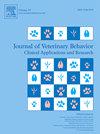Case report: Treatment of fear-based aggression and separation related-disorder in a dog using escitalopram, desipramine, and orotransmucosal dexmedetomidine
IF 1.6
3区 农林科学
Q4 BEHAVIORAL SCIENCES
Journal of Veterinary Behavior-clinical Applications and Research
Pub Date : 2025-09-25
DOI:10.1016/j.jveb.2025.09.004
引用次数: 0
Abstract
A 1 year-old female spayed Chihuahua Mix was presented for aggression and separation related distress. Physical examination and blood work did not reveal any concerns, and the patient was diagnosed with fear-based aggression towards unfamiliar people, fear and possessive aggression towards its housemate dog and cat, and separation related-disorder. The patient was prescribed a complete behavioral treatment plan including behavior modification, environmental management, and medications. Throughout the course of multiple rechecks over nearly 3 years the medication protocol evolved and stabilized as a combination of escitalopram at 2.5 mg (∼0.5 mg/kg) per os (po) q. 12 h, desipramine at 25 mg (∼5 mg/kg) po q. 24 h, and dexmedetomidine (SileoⓇ) at 3 dots (∼0.014 mg/kg) oral transmucosal (OTM) for as-needed stressful events. The owner reports the patient is well controlled on the current combination therapy. This case highlights the complexities of medication management and the potential utility of escitalopram and desipramine for treatment of anxiety and aggression disorders in dogs which merits future research.
病例报告:使用艾司西酞普兰、地西帕明和经粘膜右美托咪定治疗狗的恐惧性攻击和分离相关障碍
一名1岁的雌性绝育吉娃娃混血被提出攻击和分离相关的痛苦。体检和血液检查未发现任何担忧,患者被诊断为对不熟悉的人的恐惧性攻击,对其室友狗和猫的恐惧和占有性攻击,以及分离相关障碍。为患者制定了完整的行为治疗计划,包括行为矫正、环境管理和药物治疗。在近3年的多次复查过程中,用药方案不断发展并稳定为艾司西酞普兰2.5 mg (~ 0.5 mg/kg) / s (po) q. 12 h,地西帕明25 mg (~ 5 mg/kg) / q. 24 h,右美托咪定(SileoⓇ)3 dots (~ 0.014 mg/kg)口服经膜(OTM)治疗所需的压力事件。业主报告说,病人在目前的联合治疗下控制得很好。这个案例强调了药物管理的复杂性,以及艾司西酞普兰和地西帕明在治疗狗的焦虑和攻击障碍方面的潜在效用,值得未来的研究。
本文章由计算机程序翻译,如有差异,请以英文原文为准。
求助全文
约1分钟内获得全文
求助全文
来源期刊
CiteScore
3.50
自引率
16.70%
发文量
107
审稿时长
325 days
期刊介绍:
Journal of Veterinary Behavior: Clinical Applications and Research is an international journal that focuses on all aspects of veterinary behavioral medicine, with a particular emphasis on clinical applications and research. Articles cover such topics as basic research involving normal signaling or social behaviors, welfare and/or housing issues, molecular or quantitative genetics, and applied behavioral issues (eg, working dogs) that may have implications for clinical interest or assessment.
JVEB is the official journal of the Australian Veterinary Behaviour Interest Group, the British Veterinary Behaviour Association, Gesellschaft fr Tierverhaltensmedizin und Therapie, the International Working Dog Breeding Association, the Pet Professional Guild, the Association Veterinaire Suisse pour la Medecine Comportementale, and The American Veterinary Society of Animal Behavior.

 求助内容:
求助内容: 应助结果提醒方式:
应助结果提醒方式:


